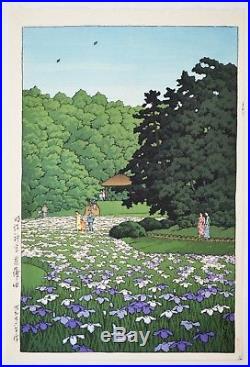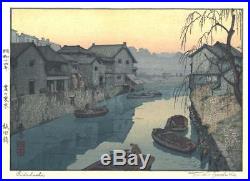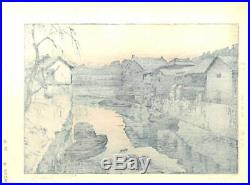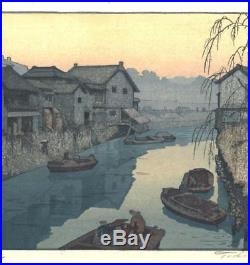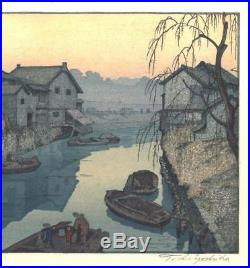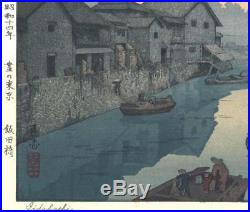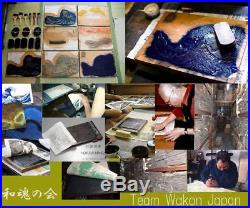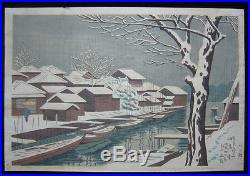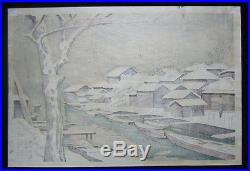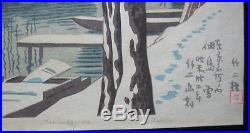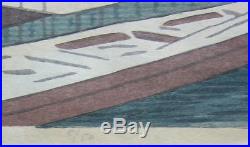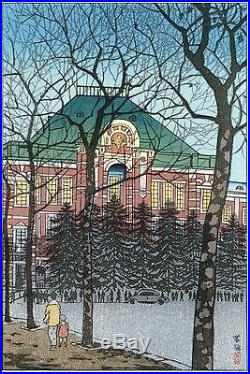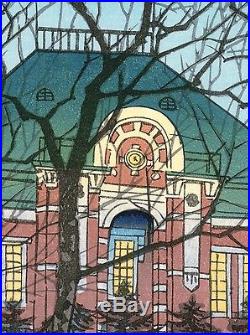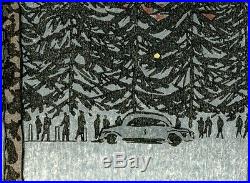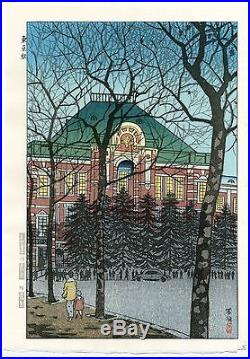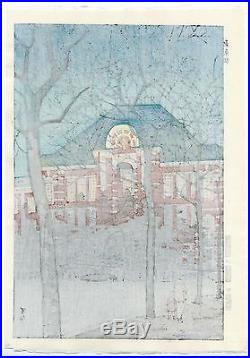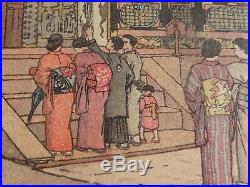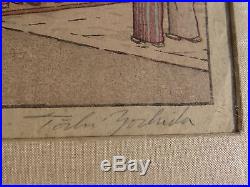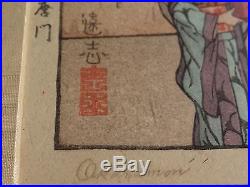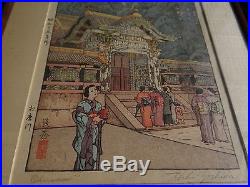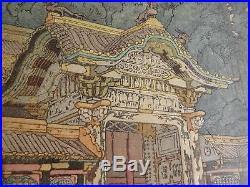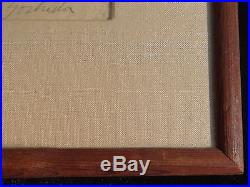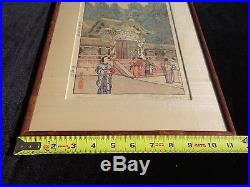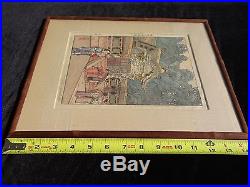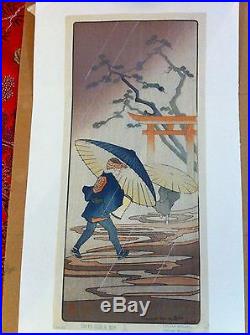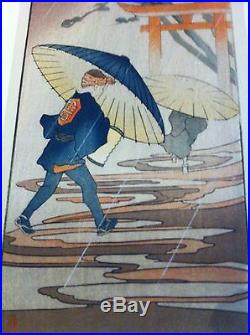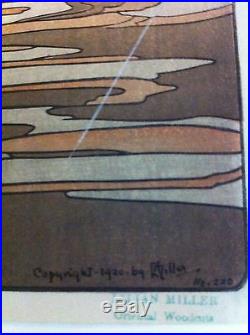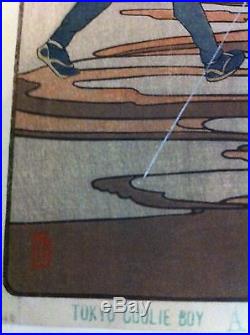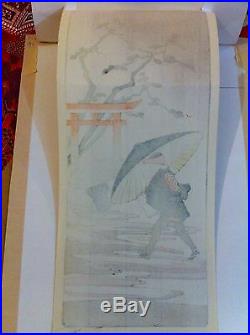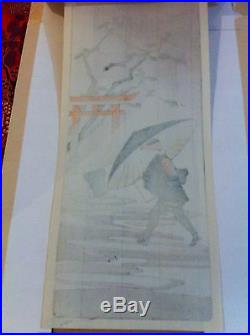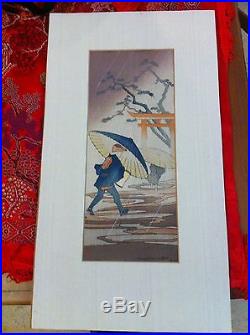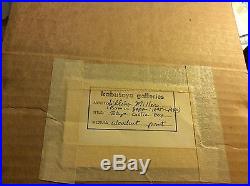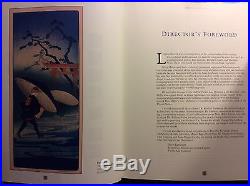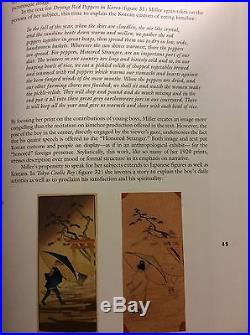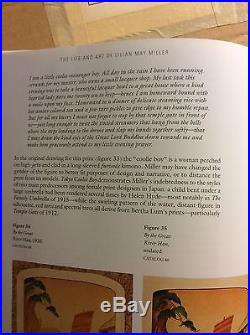Lilian may Miller, Japanese woodblock print, Tokyo Coolie Boy A, 1920, signed. Image size is 4.5″ x 10.75, ” matted size is approximately 9 by 16 1/2 Inches. It has one light bend on top part, and it is mounted in 2 small points at top margin, paper quality is very good with no stains and no repairs, nice and strong color. There is a stams at the back cartoon frame from “Kabutoya Gallery” in Tokyo, this gellery was and still is a famous and important gallery, the best Artists where introduced here. I also attached few photos from Lilian May Miller book by Kendall H. Brown illustrated this print with some nice explenations of the artist. Lilian May Miller (July 20, 1895 – January 11, 1943) was an American painter. Miller lived her life “between two worlds”, connecting two hemispheresthe East and the West, as well as the feminine and the masculine. In the world of art she marked her place with imagery, while she attended presentations in traditional kimonos. And signed her paintings with a monogram. In her personal life she hiked California’s San Gabriel Mountains. She never married and she supported herself solely through the sale of her art. Miller saw Japanese painting and print-making as her first and foremost mode of artistic expression. She practiced oil painting. Trained in Japan in traditional painting styles and techniques, Lilian May Miller created lyrical sketches, ink paintings and woodblock prints representing people and landscapes from Japan and Korea. The countries where she spent most of her life. Lilian May Miller was born in Tky. Japan, on July 20, 1895. Her father, Ransford Miller, had worked at the American embassy in Tokyo from 1890, while her mother, Lilly Murray (who had arrived in Japan as a missionary in 1888), taught English at the Christian mission. A couple of years later, the Miller family welcomed a second daughter, Harriet Hartmann, on October 2, 1897. In 1904, at the suggestion of well known etcher. (18681919), Ransford Miller enrolled nine-year-old Lilian in the atelier of Kano Tomonobu (18431912), who was the 9th generation head of the famous Kan school. In 1907, Lilian continued her studies under the supervision of artist, Shimada Bokusen (18671941), and exhibited her first works that year. It is Shimada Bokusen the one who conferred her a distinct gô (art name) — Gyokka (Jeweled Flower). In 1909 her father was transferred back to Washington, D. Leaving Japan for the first time in her life, she went to the United States. From Western High School, she went to Vassar College in New York. Where she was a classmate of the famous poet Edna St. , graduating in 1917 with a Bachelor of Arts Degree. Then she went to Seoul. Korea, where her father was now the American Consul General. After she spent about a year with her parents, in September 1918 she went to work as a secretary in the Division of Political Affairs at the State Department in Washington, D. Lilian painted ” In a Korean Palace Garden ” (based on a sketch she had made in Korea), which was presented at the Imperial Salon of Tky’s Imperial Academy of Fine Arts. Her painting won a Tokusenjo (Special Merit award), one of the five awards in a competition that held 500 participants. It was in September 1920 that she turned to woodblock print. She was living as the tenant of the artist and promoter Bertha B. (18691954), and she had turned to printmaking as a way of supplementing her income. It is presumably thanks to Lum that Miller began to work with the block-carver Matsumoto (who had previously worked for Helen Hyde) and the printer Nishimura Kumakichi 1861 ca. 1941, whom Bertha Lum had come to rely on completely for her own print productions. Shortly thereafter there was a dramatic falling-out between the two artists. Interestingly, Miller also struggled with a relationship with Elizabeth Keith, who began as a friend but later developed into a rival. By 1922, Lilian Miller is said to have produced more than 6,000 prints and holiday cards. Many Japanese and American newspapers run articles and stories depicting her avant la lettre do-it-yourself devotion and particular artistic finesse. On September 1923 Tky was largely destroyed by the great Kanto Earthquake. While Lilian was in Seoul on a visit to her parents. Her entire studio was destroyed, including all her woodblocks and the materials for a book of poems, ” Grass Blades “, which she was preparing for printing. Soon Lilian fell seriously ill, presumably because of beriberi. A vitamin-deficiency disease, and she spent three years recuperating in her parents home in Seoul. In 1927 she was well enough to work, and she succeeded in publishing a revised version of her poetry book ” Grass Blades from a Cinnamon Garden “. She began producing new prints, including re-issues of earlier works. Stresses the visual quality of many of the poems, and concludes that while her poetry was often flat and contrived, her art was becoming increasingly radiant and natural. ” A number of the poems in the volume are ardent expressions of love addressed, it seems, to women, and Brown remarked: ” The feminized Orient, alternately maternal and sexual, is easily linked to the desired lover who is at once the gentle teacher and the object of amorous desire. Thus, the Orient becomes the lover and the lover becomes the Orient, both ideal states of grace and sites of feminine creativity. Lilian made a six-month visit to the United States in 1929/1930 to renew contacts with the American art world. While touring the U. She gave woodblock printing demonstrations at galleries and museums in Boston, New York City, Philadelphia, Washington, Chicago, Kansas City, Denver, San Francisco, and Pasadena. During her lectures, exhibitions and elegant one-woman shows in America, she wore an elaborate kimono. Miller was frequently profiled in the newspapers, especially since she was genuinely admired by the artistic community for executing the entire process of woodblock printing by herself, including the block-cutting stage. Her works had already been added to the collections of the Chicago Art Institute. And the British Museum. Progressively, Lilian Miller’s collectors and dealers gathered a network of key female art patrons and admirers of the time, including Empress Nagako. Of Japan, Lou Henry Hoover. The wife of U. Aviator and spouse of famous Charles Lindbergh. , and Grace Nicholson, a renowned Pasadena. It was Nicholson’s Pasadena residence, now the Pacific Asia Museum. Where Miller perhaps felt most at homeoutside Japan. Their friendship enabled Miller to meet and make use of many important art contacts on her American trip and after wards. And became head of the Far Eastern Department in the State Department, Washington. He died in 1932; another ceremonial funeral was also held in Tokyo in October 1932 when Lilian and her mother took his ashes to Yokohama Foreign Cemetery. From then on, Lilly Miller stayed with her daughter. In the 1930s, during The Great Depression. Miller evolved to a new style of watercolor painting. Her works were made with a flat Japanese brush, with Japanese pigments and paper. And strongly influenced by Yoshida Hiroshi. Two leading Japanese shin hanga. In 1935, Lilian Miller’s health deteriorated. She had surgery for a large cancerous tumor, including a hysterectomy. In early 1936, after a political imbroglio in which Japanese radical officers assassinated several leading politicians, Lilian and her mother left Japan and moved to Honolulu. In 1938, in the 10th exhibition of the Honolulu Print Makers , she exhibited a print depicting bamboo using a lithotint method a kind of lithography. That achieved the effect of ink painting. She spent her final years traveling in the U. To promote her print sales and to visit friends. In the autumn of 1938 she moved to San Francisco. Obviously, the massive redwoods. Of California reminded her of growing up in Nikk. And she began to include them in her work. The Japanese attack on Pearl Harbor. In December 1941 was a terrible shock to her, but she din not hesitate to serve her country. She signed on with a Naval counter propaganda branch as a Japanese Censor and Research Analyst in Washington, D. But late in 1942, another cancerous tumor was discovered. Lilian May Miller died on January 11, 1943. ” Lilian Miller, An Artist in Japan ” (” Impressions ” #28, 2006). ” Between Two Worlds: The Life and Art of Lilian May Miller ” (first edition, Pacific Asia Museum, Pasadena, 1998; an illustrated edition published by University of Washington Press, 2000). Your satisfaction guarenteed, if you are not pleased with the item please send it back. WE WILL NOT CHARGE ADDITIONAL PAYMENTS FOR MULTIPLE AUCTIONS, YOU CAN. The item “Lilian may Miller, Japanese woodblock print, Tokyo Coolie Boy, 1920, signed” is in sale since Saturday, January 12, 2013. This item is in the category “Art\Art Prints”. The seller is “moses_collectibles” and is located in Petah-Tikwa, default. This item can be shipped worldwide.
- Original/Reproduction: Original Print
- Listed By: Dealer or Reseller
- Signed: Signed
